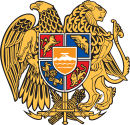Political System of Armenia Հայաստանի պետական համակարգ | |
|---|---|
 | |
| Polity type | Unitary parliamentary republic |
| Constitution | Constitution of Armenia |
| Legislative branch | |
| Name | National Assembly |
| Type | Unicameral |
| Meeting place | National Assembly Building |
| Presiding officer | Alen Simonyan, President of the National Assembly |
| Executive branch | |
| Head of state | |
| Title | President |
| Currently | Vahagn Khachaturyan |
| Appointer | National Assembly |
| Head of government | |
| Title | Prime Minister |
| Currently | Nikol Pashinyan |
| Appointer | President |
| Cabinet | |
| Name | Government of Armenia |
| Current cabinet | Pashinyan government |
| Leader | Prime Minister |
| Appointer | President |
| Headquarters | Government House |
| Ministries | 12 |
| Judicial branch | |
| Name | Judiciary of Armenia |
| Constitutional Court of Armenia | |
| Chief judge | Hrayr Tovmasyan |
| Seat | Yerevan |
| Part of a series on |
| Armenia Հայաստան |
|---|
  |
| Culture |
| History |
| Demographics |
| Administrative divisions |
|
 |
|---|
|
|
The politics of Armenia take place in the framework of the parliamentary representative democratic republic of Armenia, whereby the president of Armenia is the head of state and the prime minister of Armenia the head of government, and of a multi-party system. Executive power is exercised by the president and the Government. Legislative power is vested in both the Government and Parliament.[1][2][3]
- ^ Shugart, Matthew Søberg (September 2005). "Semi-Presidential Systems: Dual Executive and Mixed Authority Patterns" (PDF). Graduate School of International Relations and Pacific Studies. dss.ucsd.edu. United States: University of California, San Diego. Archived from the original (PDF) on 19 August 2008. Retrieved 13 October 2017.
- ^ Shugart, Matthew Søberg (December 2005). "Semi-Presidential Systems: Dual Executive And Mixed Authority Patterns" (PDF). Graduate School of International Relations and Pacific Studies, University of California, San Diego. French Politics. 3 (3): 323–351. doi:10.1057/palgrave.fp.8200087. ISSN 1476-3427. OCLC 6895745903. Archived (PDF) from the original on 2022-10-09. Retrieved 13 October 2017.
Table 1 shows that dissolution power as a presidential initiative is rare in the contemporary president-parliamentary systems. In fact, only in Armenia may the president dissolve (once per year) without a trigger (e.g. assembly failure to invest a government).
- ^ Markarov, Alexander (2016). "Semi-presidentialism in Armenia". In Elgie, Robert; Moestrup, Sophia (eds.). Semi-Presidentialism in the Caucasus and Central Asia. London: Palgrave Macmillan UK (published 15 May 2016). pp. 61–90. doi:10.1057/978-1-137-38781-3_3. ISBN 978-1-137-38780-6. LCCN 2016939393. OCLC 6039792321. Retrieved 8 October 2017.
Markarov discusses the formation and development of the semi-presidential system in Armenia since its foundation in 1991. The author identifies and compares the formal powers of the president, prime minister, and parliament under the 1995 Constitution as well as the amendments introduced through the Constitutional referendum in 2005. Markarov argues that the highly presidentialized semi-presidential system that was introduced in the early 1990s gradually evolved into a Constitutionally more balanced structure. However, in practice, the president has remained dominant and backed by a presidential majority; the president has thus been able to set the policy agenda and implement his preferred policy.